

ESXi 5 Won't Boot From USB - VMtoday. I’ve been upgrading my home VMware lab to vSphere 5.1 today and ran into an issue that I thought I would share.
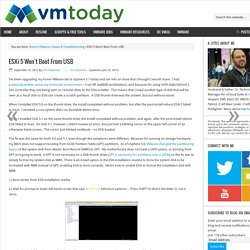
I had previously written about my home lab environment - I run HP xw8600 workstations, and because I’m using SATA disks behind a SAS controller they are being seen as ‘remote’ disks to the ESXi installer. This means that I need another type of disk that will be seen as a ‘local’ disk so ESXi can create a scratch partition. A USB thumb drive was the answer, but not without issues. When I installed ESXi 5.0 on the thumb drive, the install completed without problem, but after the post-install reboot ESXi 5 failed to boot. I received a non-system disk / no bootable device error. When I installed ESXi 5.1 on the same thumb drive, the install completed without problem, and again, after the post-install reboot ESXi failed to load. The fix was the same for both 5.0 and 5.1, even though the symptoms were different. HP ProLiant n54l BIOS modification guide – Allow Hot-Plug SATA and 5th SATA port. This article describes how to perform a BIOS modification on the HP n54l microserver.
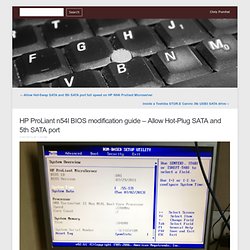
Firstly, I’ll list the two reasons why I wanted this modification, then I’ll list the steps required to carry it out. The n54l has 4 ‘Non-Hotswap’ bays. These are only non-hotswap in bios, with a modification these can be made hotswappable.There is an unused SATA port on the motherboard, intended for use with a disk drive in the 5.25″ bay. With a BIOS modification, this port can be forced to run at full speed (6Gb/s) and so a SATA hard drive can be used in this bay. Before starting, it’s worth you taking a look at the stock bios, that way, when you’ve followed the guide you’ll know it’s worked by seeing the difference. Before going any further, I should probably post some sort of disclaimer.
With that out the way, let’s get started! 1) Download SP54344.exe – This allows you to format a memory stick which can flash the BIOS. 2) Extract and run SP54344.exe. NAS Xpenology sur HP N54L ~~ Update DSM 5.0 ~~ [Worklog] - Modding - Overclocking, Cooling & Modding. Migrating VMs from VMware Server to ESXi without VMware Converter. Following are my notes on migrating VMware server VMs to ESXi platform without VMware converter.
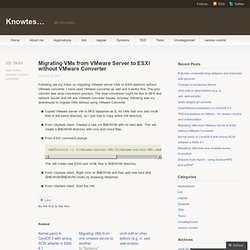
I have used VMware converter as well and it works fine. The only concern was slow conversion process. The slow conversion might be due to NFS and network issues and not any VMware converter issues. Anyway, following was my workaround to migrate VMs without using VMware Converter. Copied VMware server VM to NFS datastore as $. [GUIDE] Nanoboot ESXi 5.5.0 Perfect Install. I've been lurking in this forum for awhile and have learned quite a bit and figured it's time to contribute back and maybe help someone else.
![[GUIDE] Nanoboot ESXi 5.5.0 Perfect Install](http://cdn.pearltrees.com/s/pic/th/xpenology-nanoboot-perfect-86988289)
I'd like to thank Trantor, sancome, Diverge, Poechi, and anyone else I've missed with sharing there knowledge that made this guide possible. This guide will provide step by step instructions to create the "Perfect Install" of Nanoboot on your ESXi host. I am calling this the "Perfect Install" because when you are done there won't be any extra "unused" disk showing up in DSM, nor will your disks start in the 3rd or 4th slot, also your Nanoboot boot drive won't get overwritten during install.
You are left with something like this... Nice, Clean, Perfect! NanoBoot 5.0.3.1 (x64) & 5.0.2.4 (x86) Performance Comparison of Rumored HP ProLiant G8 MicroServer CPU’s G630T & G530T. By: John Stutsman When I saw CSKenney’s thread HP ProLiant Gen8 MicroServer Leaked Specs on the Home Server Show Forums one of the first questions I had was how did the “rumored” CPU’s for the G8 MicroServer compared to previous MicroServer’s and Home Servers.
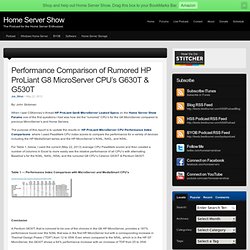
The purpose of this report is to update the results in HP ProLiant MicroServer CPU Performance Index Comparisons where I used PassMark CPU index scores to compare the performance for a variety of devices including the HP MediaSmart series and the HP MicroServer’s N36L, N40L, and N54L. For Table 1, below, I used the current (May 22, 2013) average CPU PassMark scores and then created a number of columns in Excel to more easily see the relative performance of all CPU’s with alternating Baseline’s for the N36L, N40L, N54L and the rumored G8 CPU’s Celeron G530T & Pentium G630T.
Domotique34 n54l. [Topic unique] Serveur Hp N54L + Xpenology - Page 16 - Multimédia - Domotique-fibaro - Page 16. Synology DSM 4482 (Gnoboot to NanoBoot) - CyanLabs. Introduction First thing i have to say is… Nanoboot is so fast, it’s amazing!
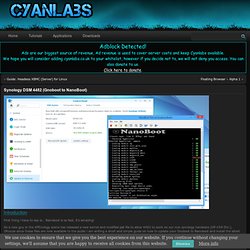
So a new guy in the XPEnology scene has released a new kernel and modified pat file to allow 4482 to work on our non synology hardware (HP n54l Etc.), Ofcouse since these files are now avaliable to the public i am writing a short and simple guide on how to update your Gnoboot to Nanoboot and install the latest Synology DSM version (at the time of posting 4482 is the latest), This guide will be using ESXi however if your not using ESXi just ignore the VM related things and win32diskimage the .img to the usb instead of adding it to the datastore etc.
Requirements Preparation Ok so since this guide assumes you already using Gnoboot and ESXi and most likely follow my other guide we need to remotely access our ESXi install via Vsphere and upload the nanoboot vmdk Installation Right lets get to it, First we need to shutdown our existing VM, Now we need to upload 1 file to our DataStore. Now we add our Nanoboot Hard Disk. Version DSM 5.4493. Producted by Sancome. HP ProLiant MicroServer G7 et G8 [Topic Unique] - Mini PC. Processeur Dual-Core: Existe en 2 versions : - Intel Celeron G1610T (2 core, 2.3 GHz, 2MB, 35W) - Intel Pentium G2020T (2 core, 2.5 GHz, 3MB, 35W) Indice PassMark : 2573Chipset: Intel C204 Chipset Carte Graphique: Matrox G200 ( max : 1280 x 1024 @32 bpp ou 1920 x 1200 @16 bpp )
![HP ProLiant MicroServer G7 et G8 [Topic Unique] - Mini PC](http://cdn.pearltrees.com/s/pic/th/proliant-microserver-hardware-73606298)
Review: HP Proliant N54L Microserver. UPDATE: I’ve upgraded since then – see new server.

There’s home servers and there’s home servers. About two years ago, I rigged up a simple DIY NAS machine, running Unraid in order to cobble together a mish-mash of HDD’s of various shapes and sizes. It works well, was cheaper and more flexible than off-the-shelf solutions and still works well to this day. Consuming around 65-85w, it’s not particularly thirsty, about par for the course for the components. Despite two of the Seagate hard disks dying along the way, and a few new HDD’s being slapped in, it’s still chugging along nicely, but it’s duties have grown. I knew of the popularity and rabid fan base of the HP Microservers, so when a special came up to pick up one of these for a measly sum a month ago, I jumped at the opportunity. Front loader for easy access to internal USB and HDD bays. Fortunately, I had a spare 750GB HDD handy, and I was ready to donate 8GB of my desktop’s 16GB of DDR3 to the machine. TUTO: NAS SYNOLOGY DSM 5 SUR SERVEUR HP N54L. Vous cherchez un NAS pour stocker vos données en réseau, vous devez installer plusieurs disques durs dedans ou vous avez besoin d’une solution évolutive.
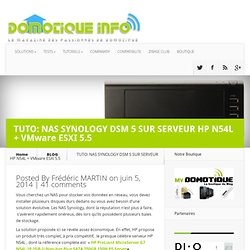
Les NAS Synology, dont la réputation n’est plus à faire, s’avèrent rapidement onéreux, dès lors qu’ils possèdent plusieurs baies de stockage. La solution proposée ici se révèle assez économique. En effet, HP propose un produit très complet, à prix compétitif, le presque célèbre serveur HP N54L , dont la référence complète est « HP ProLiant MicroServer G7 N54L 1P 2GB-U Non-hot Plug SATA 250GB 150W PS Server« Le but de ce tutorial est de construire une machine bien plus évoluée qu’un « simple » NAS SYNOLOGY, qui permettra dans un premier temps de créer un « vrai » NAS Synology avec la dernière version logicielle DSM 5-4482, mais ensuite d’installer d’autres systèmes (Windows, LINUX, …) totalement indépendant et fonctionnant en même temps, et ce, par le biais du logiciel de Virtualisation VMware ESXi 5.5.
HP Proliant MicroServer. Viewing page 7 of 7 pages.
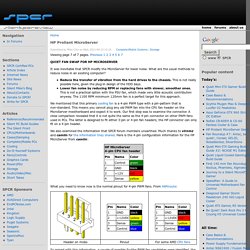
Previous 1 2 3 4 5 6 7 It was inevitable that SPCR modify the MicroServer for lower noise. What are the usual methods to reduce noise in an existing computer? Reduce the transfer of vibration from the hard drives to the chassis. This is not really possible here, given the plug-in design of the HDD bays.